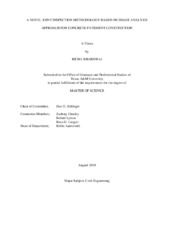| dc.contributor.advisor | Zollinger, Dan G | |
| dc.creator | Bhardwaj, Richa | |
| dc.date.accessioned | 2019-01-18T15:40:41Z | |
| dc.date.available | 2020-08-01T06:36:56Z | |
| dc.date.created | 2018-08 | |
| dc.date.issued | 2018-08-05 | |
| dc.date.submitted | August 2018 | |
| dc.identifier.uri | https://hdl.handle.net/1969.1/174064 | |
| dc.description.abstract | Sealed sawcut joints are an essential feature of jointed concrete pavement construction and performance as they not only accommodate movements associated with concrete slabs but also prevent entry of moisture and incompressibles into the joint. Quality adhesion between sealant and concrete is critical for optimum performance of sealed joints. If present in significant amounts, contaminants like dirt and moisture on joint surfaces at the time of sealant installation adversely influence the sealant-concrete adhesion leading to premature failures. Presently, there are little or no definitive criteria for maximum tolerable contamination levels, which won’t affect the durability of the adhesive bond between sealant and concrete. There is a need of critical construction items for engineers to specify and for inspectors to determine if a sawcut joint is sufficiently clean for sealant installation in order to reduce the frequency of debonding failures.
This research study aims at developing reliable surface assessments through the use of image analysis for different dirt levels on joint walls. Images of sawn concrete surfaces were analyzed through Image J software, which is able to capture changes in surface texture due to dirt accumulation in terms of surface height and area parameters. While dirt was quantified through imaging, moisture contamination was quantified with microwave technology. These indirect measurements of surface contamination were verified with tensile bond strength testing. Adhesion between sealant and concrete was studied at different contamination levels of dirt and moisture at different ages of concrete. Fresh concrete sealing and resealing cases were investigated separately, due to different boundary conditions for fresh sealant in both cases. Implications of this study involve the relation of these indirect measurement parameters with bond strength and specification criteria to govern the quality of sealant installation under field conditions. | en |
| dc.format.mimetype | application/pdf | |
| dc.language.iso | en | |
| dc.subject | Joint | en |
| dc.subject | image analysis | en |
| dc.subject | adhesion | en |
| dc.title | A Novel Joint Inspection Methodology Based on Image Analysis Approach for Concrete Pavement Construction | en |
| dc.type | Thesis | en |
| thesis.degree.department | Civil Engineering | en |
| thesis.degree.discipline | Civil Engineering | en |
| thesis.degree.grantor | Texas A & M University | en |
| thesis.degree.name | Master of Science | en |
| thesis.degree.level | Masters | en |
| dc.contributor.committeeMember | Grasley, Zachary | |
| dc.contributor.committeeMember | Lytton, Robert | |
| dc.contributor.committeeMember | Langari, Reza | |
| dc.type.material | text | en |
| dc.date.updated | 2019-01-18T15:40:41Z | |
| local.embargo.terms | 2020-08-01 | |
| local.etdauthor.orcid | 0000-0002-4392-1198 | |


